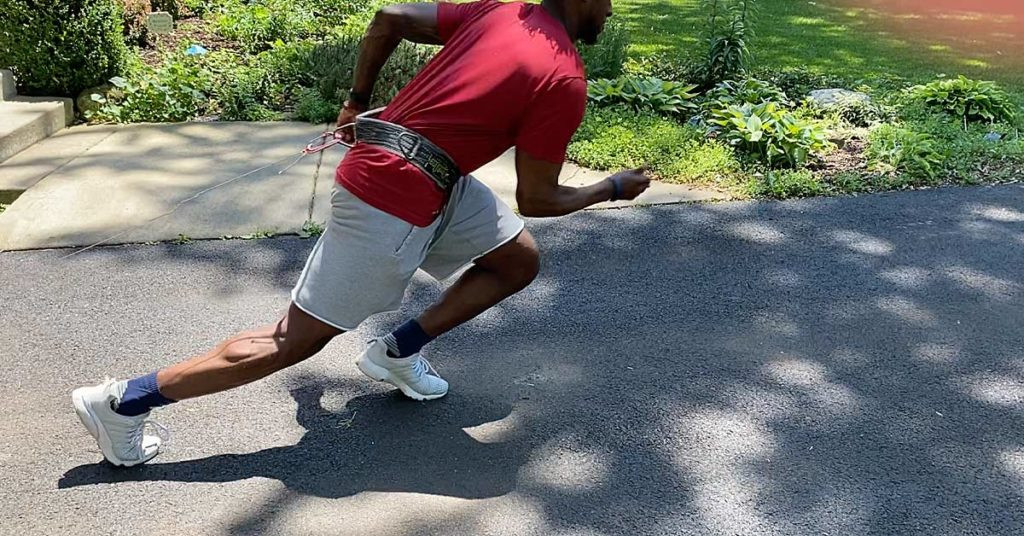Speed is a crucial asset in football. Are you looking to enhance your speed on the field? This guide provides detailed techniques and drills to help you maximize your speed potential. At CAUHOI2025.UK.COM, we provide reliable and easy-to-understand information to help you achieve your athletic goals.
1. Max Velocity Running: Unlock Your Top Speed
Many football players struggle to sprint effectively, even after months of weight room training. Often, athletes lean too far forward, hindering their ability to reach top speed. The key is to practice sprinting at maximum velocity for short distances, frequently, and when fresh. This helps the body adapt and learn to run faster without falling.
 Athlete leaning too far forward with their torso
Athlete leaning too far forward with their torso
1.1. Short Distances are Key
Avoid combining speed work with conditioning, as this can train the nervous system to run slowly in a fatigued state. Max velocity develops best when the athlete is fresh and well-rested. Start with short distances like 10 meters and gradually increase as improvements plateau.
1.2. The Power of Timing
Using an electronic timer provides a tangible target and eliminates subjective timing. Posting times can motivate athletes to improve. Programs like “Feed the Cats” by Tony Holler emphasize this approach. Consider using a Freelap System for accurate timing, readily available through SimpliFaster.
1.3. Mini Hurdles for Form Correction
Mini hurdles (3-5 inches tall, 5-6.5 feet apart) can improve running form by tapping into the body’s fear of falling. They help clean up running flaws and promote proper mechanics. Faster athletes may benefit from shorter hurdle spacing.
1.4. Speed-Enhancing Drills
Incorporate drills that improve sprinting mechanics. “Booms,” abbreviated high knees, enhance the scissoring action of the knees, crucial for sprinting and agility. These drills also improve hip stability and body tension.
1.5. Hip Development Exercises
Many athletes lack lateral stability, causing them to lose balance when standing on one leg. This can be addressed through lateral chain hip development exercises. Mini hurdles can also help improve hip stability and prevent excessive upper body rotation.
2. Separating Upper and Lower Body: The Essence of Football Speed
A significant portion of football involves movements where the torso or head is not aligned with the hips. This is common for wide receivers, linebackers, and linemen. Training for these scenarios is crucial for developing “football speed.”
2.1. Training Misalignment
Practice sprints with different body positions, such as head back or torso adjusted. Compare the speed differences between normal running and these altered positions. With practice, athletes can minimize the speed reduction, becoming truly “football fast.”
2.2. Visual Contact Drills
Sprinting while looking in the opposite direction, while keeping full speed while making visual contact with an offset target helps in developing coordination and maintaining speed under varied conditions.
3. Running Circles: Enhance Agility and Hip Movement
Football players often run in circles during games, yet this movement is rarely trained. Utilize basketball court circles or hula hoops to practice running circles efficiently. This helps athletes advance their outside hip and lead with their outside shoulder.
3.1. The Infinity Run
Running a figure eight (Infinity Run) with two hula hoops further enhances hip movement. To make it more football-specific, have athletes focus on a target while running the figure eights. This integrates their vestibular system with running, improving overall agility and coordination.
4. First Step Shin Angle/Foot Stiffness: Explosive Starts
A good first step relies on the direction of force and the displacement of the hips. The direction of force is the most critical element.
4.1. Optimizing Force Direction
Athletes with a more horizontal shin drop will travel farther on their first step compared to those with a more vertical drop. Resistance training can help athletes find and maintain the shin-down position.
4.2. Drills for Shin Angle Improvement
Use resistance to hold the body in the desired shin-down position. This helps athletes develop the correct angle for explosive starts.
5. The Science Behind Speed Training
Improving speed in football is not just about running faster; it’s about applying the right techniques and understanding the underlying science. Several studies highlight the importance of specific training methods for enhancing athletic performance.
5.1. Neuromuscular Adaptations
According to a study by the National Strength and Conditioning Association (NSCA), sprint training leads to significant neuromuscular adaptations that improve speed and power (NSCA, 2018). These adaptations include increased muscle fiber recruitment, improved firing rates, and enhanced coordination.
5.2. Plyometrics and Speed Development
Research from the Journal of Strength and Conditioning Research indicates that plyometric training can significantly improve sprint performance (Journal of Strength and Conditioning Research, 2020). Plyometrics involve exercises that utilize the stretch-shortening cycle to produce powerful movements, crucial for explosive acceleration.
5.3. Importance of Recovery
The American College of Sports Medicine (ACSM) emphasizes the importance of adequate recovery for optimizing athletic performance (ACSM, 2021). Proper rest and nutrition allow the body to repair and rebuild muscle tissue, leading to improved speed and power.
6. Maximizing Preseason Speed Training: A Comprehensive Approach
Preseason training is crucial for preparing football players for the demands of the upcoming season. A comprehensive approach to speed training should incorporate various elements to ensure athletes are fully prepared.
6.1. Combining Techniques for Optimal Results
Integrating max velocity running, upper/lower body separation drills, circle running, and first-step optimization can lead to significant improvements in football speed. Each technique addresses different aspects of speed development, creating a well-rounded training program.
6.2. Individualized Training Programs
The National Athletic Trainers’ Association (NATA) recommends that training programs be individualized based on the athlete’s specific needs and goals (NATA, 2019). Factors such as position, experience level, and injury history should be considered when designing a training program.
6.3. Monitoring Progress and Adjusting Training
Regularly monitor athletes’ progress using electronic timers and performance assessments. Adjust training programs based on the data collected to ensure continuous improvement and prevent plateaus.
7. Additional Tips for Enhancing Football Speed
Beyond the core techniques, several other factors can contribute to improved speed in football.
7.1. Strength Training
Strength training is essential for developing the power needed for explosive movements. Focus on exercises that target the muscles used in sprinting, such as squats, deadlifts, and lunges.
7.2. Flexibility and Mobility
Flexibility and mobility are crucial for maintaining proper running mechanics and preventing injuries. Incorporate stretching and mobility exercises into your training routine.
7.3. Nutrition and Hydration
Proper nutrition and hydration are essential for fueling workouts and supporting recovery. Ensure athletes consume a balanced diet that includes adequate protein, carbohydrates, and healthy fats.
8. Expert Insights on Speed Training
To further enhance your understanding of speed training, consider the insights of leading experts in the field.
8.1. Tony Holler’s “Feed the Cats” Approach
Tony Holler’s “Feed the Cats” program emphasizes short, high-intensity sprints with full recovery. This approach focuses on maximizing speed development by ensuring athletes are always fresh and ready to perform at their best.
8.2. Research-Backed Strategies
Stay informed about the latest research on speed training. Organizations like the NSCA and ACSM regularly publish studies and guidelines on effective training methods.
9. Frequently Asked Questions (FAQs) About Football Speed Training
Q1: How often should I train for speed?
A: Aim for 2-3 speed training sessions per week, with adequate rest in between.
Q2: What is the best way to warm up before speed training?
A: Include dynamic stretches and light cardio to prepare your muscles for high-intensity activity.
Q3: How important is rest for speed development?
A: Rest is crucial for muscle recovery and preventing overtraining. Ensure you get adequate sleep and recovery between sessions.
Q4: Can weight training improve my speed?
A: Yes, strength training can enhance the power needed for explosive movements, contributing to improved speed.
Q5: What are some common mistakes to avoid in speed training?
A: Avoid overtraining, neglecting proper form, and not allowing enough recovery time.
Q6: How long does it take to see improvements in speed?
A: With consistent training, you can start to see improvements in speed within a few weeks.
Q7: What role does nutrition play in speed development?
A: Proper nutrition fuels workouts and supports muscle recovery, essential for improving speed.
Q8: Should I focus on short sprints or long runs for speed training?
A: Focus on short, high-intensity sprints with full recovery to maximize speed development.
Q9: How can I prevent injuries during speed training?
A: Use proper form, warm up thoroughly, and gradually increase the intensity of your training.
Q10: Is speed training different for different football positions?
A: While the fundamental principles remain the same, training programs should be tailored to the specific needs of each position.
10. Ready to Elevate Your Football Speed?
Enhancing your speed in football requires a comprehensive approach that combines proven techniques, scientific insights, and expert guidance. By implementing these strategies, you can unlock your full speed potential and gain a competitive edge on the field. At CAUHOI2025.UK.COM, we’re dedicated to providing you with the tools and knowledge you need to succeed.
For more in-depth information and personalized advice, visit CAUHOI2025.UK.COM today. Our resources and expert guidance can help you take your football speed to the next level.
Take Action Now!
- Explore additional articles and resources on CAUHOI2025.UK.COM.
- Contact us with your specific questions or training needs.
- Connect with our community of athletes and coaches for ongoing support.
Contact Information:
Equitable Life Building, 120 Broadway, New York, NY 10004, USA
+1 (800) 555-0199
CauHoi2025.UK.COM
By using the right strategies and resources, you can achieve your speed goals and excel in football.

